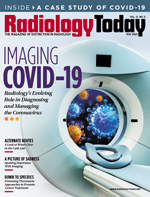 Managing to Succeed: Failure to Communicate — Three Ways Talking About Interpretive Errors Can Reduce Them
Managing to Succeed: Failure to Communicate — Three Ways Talking About Interpretive Errors Can Reduce Them
By Nina Kottler, MD
Radiology Today
Vol. 21 No. 5 P. 6
To err is human. The low but persistent rate of interpretive errors and missed diagnoses in radiology has been investigated and attributed to a range of causes, including human failure. We grow by learning from our failures. But are we getting the opportunity to learn in our current paradigm of peer review? Could the fear of failure itself contribute to diagnostic error? And, can we diminish fear through a just culture and open communication?
As the advent of team-based care fuels a focus on improving communication between radiologists and referring clinicians, let’s also shine a light on communication within our specialty. Let’s ensure that in a new era in health care, open discussion among radiologists is safe. Let’s talk about our failures so that we can learn from them.
Here are three ways we can begin.
Build a Fear-Free Culture
Traditional score-based peer review of image interpretation has been shown to inject distrust into departments—hardly a path toward effective team-based care or active learning. Grading and judging each other by the errors we make simply reinforce the taboo of failure, shutting the door to the lessons these failures have to teach. Happily, peer learning, the alternative approach to peer review, is gaining ground. Peer learning provides a greater volume of learning opportunities in a safe environment where we can analyze missed calls without grading or blame. In this paradigm, radiologists have an opportunity to build a new culture in which errors lead to learning and improvement, without risk or judgment.
Vulnerability Can Lead to Innovation
Open discussion about failure requires us to face our own vulnerability, a formidable task. Yet, the alternative is risk avoidance, a place in which learning is bypassed and the diagnostic error rate remains high. If we build a culture of belonging, a place where people feel safe to share, we can start to tackle this problem and, from that place of security, have the freedom to be creative and innovate.
As Brené Brown says in her TED Talk “The Power of Vulnerability,” “There is no innovation and creativity without failure. Period.” If our response to failure begins with an acceptance of our vulnerability, then we are ready to innovate.
With Brown’s approach in mind, we took an honest look at our practice at Radiology Partners and realized that one area for improvement was in the recommendations we were providing to our referring clinicians—there was too much variability from radiologist to radiologist. To ensure our recommendations delivered consistent, population health–driven, evidence-based best practices, we needed to innovate.
Turning to AI and natural language processing, we built recoMD, a support tool that listens to what our radiologists say as they dictate reports. Upon detecting any of several incidental pathologies and combining that information with the metadata from the patient and exam, recoMD alerts the radiologist to the evidence-based follow-up appropriate for that patient and pathology. This tool was built to fit into radiologists’ workflow, reducing variability in our recommendations while garnering acceptance and improving reporting efficiency.
Developing and launching the tool had its own moments of failure in communication and change management. However, because we developed a learning culture, each failure was an opportunity to pause, learn, and improve. The result is a consistently improving tool helping our radiologists optimize the care they provide to their patients and referring clinicians.
Close the Gender Gap
Radiology is a male-dominated field. Less than 30% of practicing radiologists in the United States are women. While numerous factors have been posed as the cause of the gender imbalance, it is likely related to a combination of multiple factors. Could one contributing factor be a fear of failure? Behavioral science has shown that women tend to be judged more harshly than men for their errors. Unfortunately, this inequity is seen regardless of the gender of the judge, even if the judge is the woman herself. As interpretation errors are inherent in radiology, a risk-avoidant woman going into medicine may well pursue another specialty.
Improving diversity drives innovation. McKinsey reports that diversity “fosters innovation and creativity through a greater variety of problem-solving approaches, perspectives, and ideas.” It’s a virtuous cycle: Risk-free communication about and learning from our failures in a culture of safety and belonging may bring more women into our field, which in turn will foster creativity and drive innovation.
Resources are in place to support women in health care. In radiology, Geraldine McGinty, MD, (@DrGMcGinty on Twitter) and Ambra Health (@ambrahealth) launched #RADxx to encourage networking and advocacy among women in radiology and informatics. This community has grown to more than 200 women and men. Using the Twitter hashtags #WomeninHIT, #RADxx, and #RadWomen, women can join an ongoing, online support group fostering open discussion.
It’s About Our Patients
Health care is beginning to undergo a massive transformation. In the midst of great change, new directions are possible. Let’s take this unsettled time to promote the changes that will improve outcomes for our patients. To achieve this mission, we need to create and foster a culture of belonging and safety, a place where failure is considered a learning opportunity. Only then will we be free to discuss, learn, innovate, and transform.
— Nina Kottler, MD, is vice president of clinical operations for Radiology Partners. Connect with her on Twitter @RADKottler.

